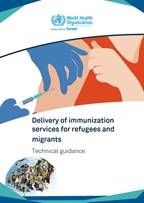
Module 1
Short- and long-term public health interventions to promote refugee and migrant health

Tool 4: Immunization
Tool overview
Immunization is one of the world’s most cost-effective health interventions, saving millions of lives globally and making more than 20 life-threatening diseases now preventable. Vaccines will invariably play a critical role in achieving GPW 13 and delivering on its Triple Billion Targets, UHC and the SDGs through reducing poverty and morbidity and mortality from vaccine-preventable diseases. While significant progress has been made in reducing the incidence of vaccine-preventable diseases globally, significant challenges remain, with global coverage for key routine immunizations still below optimal levels.
The Immunization Agenda 2030: A Global Strategy to Leave No One Behind (IA2030) in World Health Assembly resolution WHA73 defines what needs to happen next to drive improvements in global immunization coverage. It presents a vision of "a world where everyone, everywhere, at every age fully benefits from vaccines for good health and well-being". IA2030 defines strategic priorities to ensure immunization is accessible by all people and contributes to UHC and sustainable development, alongside setting new and ambitious targets globally by 2030, including increasing vaccine coverage to 90% for three doses of the combined diphtheria, tetanus and pertussis vaccine; two doses of the measles vaccine; pneumococcal conjugate vaccine; and human papillomavirus vaccine; and delivering a 50% reduction in the number of zero-dose children, with the aim of averting 50 million future deaths. A framework for action for implementation of IA2030 has been created.
To achieve this, it is acknowledged that an increased emphasis is needed on equity and vulnerable populations and a stronger focus on immunization across the life course to promote well-being for all at all ages. This includes refugees and migrants. The extent to which refugee and migrant populations specifically are underimmunized globally has been poorly defined to date. Migration and displacement is considered to be one of several processes influencing low immunization uptake. Data suggest that adults, adolescents and child migrants are an underimmunized group in several contexts for routine vaccines and may have a higher burden of vaccine-preventable disease s than host populations.
Guidance and tools
Guidance, training, reports
Vaccinating older adults against COVID-19
The objective of this document is to identify successful strategies, enablers and examples of successful strategies to identify and offer vaccine doses...
Vaccination in acute humanitarian emergencies
This decision-framework document aims to provide and approach for deciding which vaccines, if pre-emptively and properly delivered at the outset of an...
Humanitarian emergencies, regardless of type and cause, have a number of common risk factors for communicable diseases inextricably linked to excess risk...

This technical guidance outlines current best practice, evidence and knowledge in order to support policy and programme development for vaccination of...
COVID-19 immunization in refugees and migrants: principles and key considerations: interim guidance,...
Although everyone is affected by the COVID-19 pandemic, the impact is not shared equally. The COVID-19 pandemic has exposed vulnerabilities and exacerbated...
